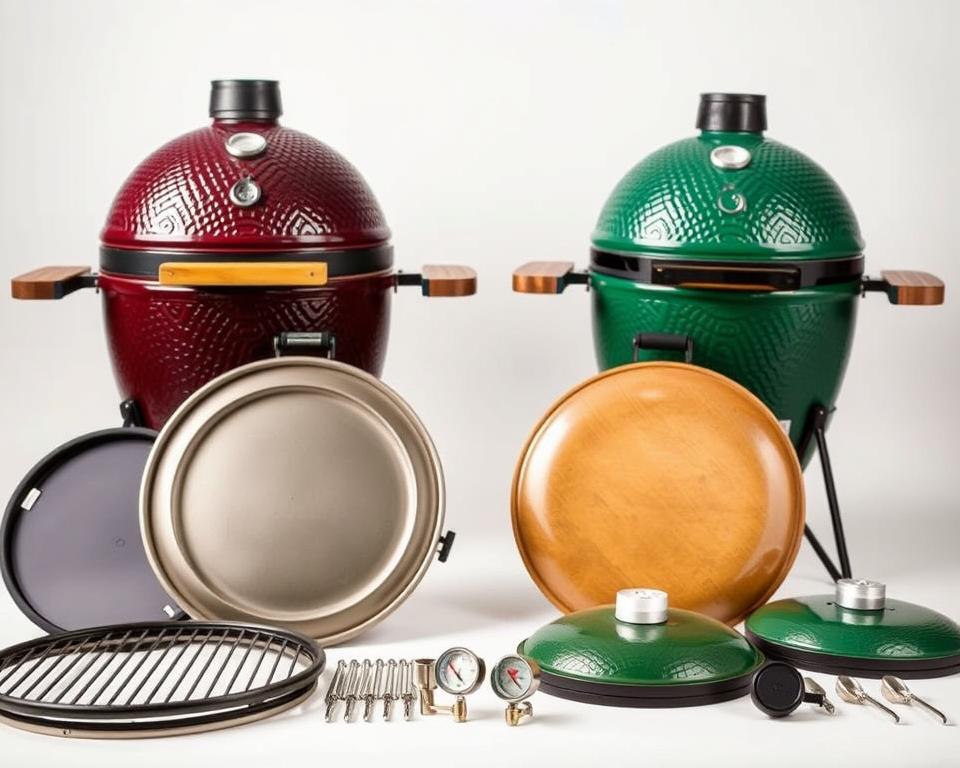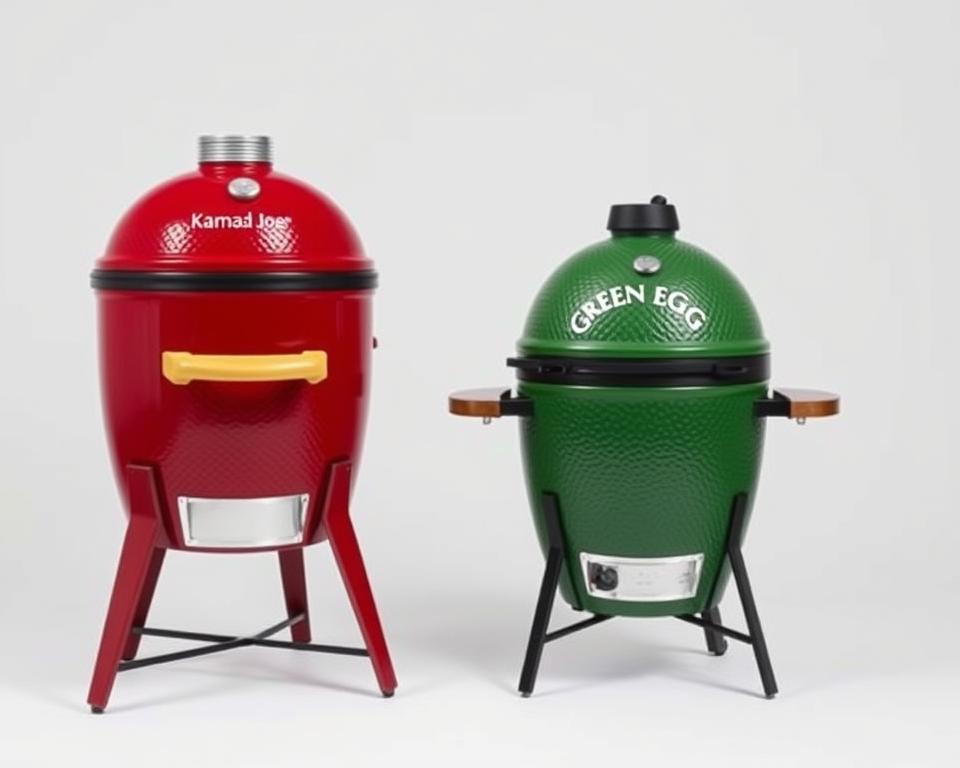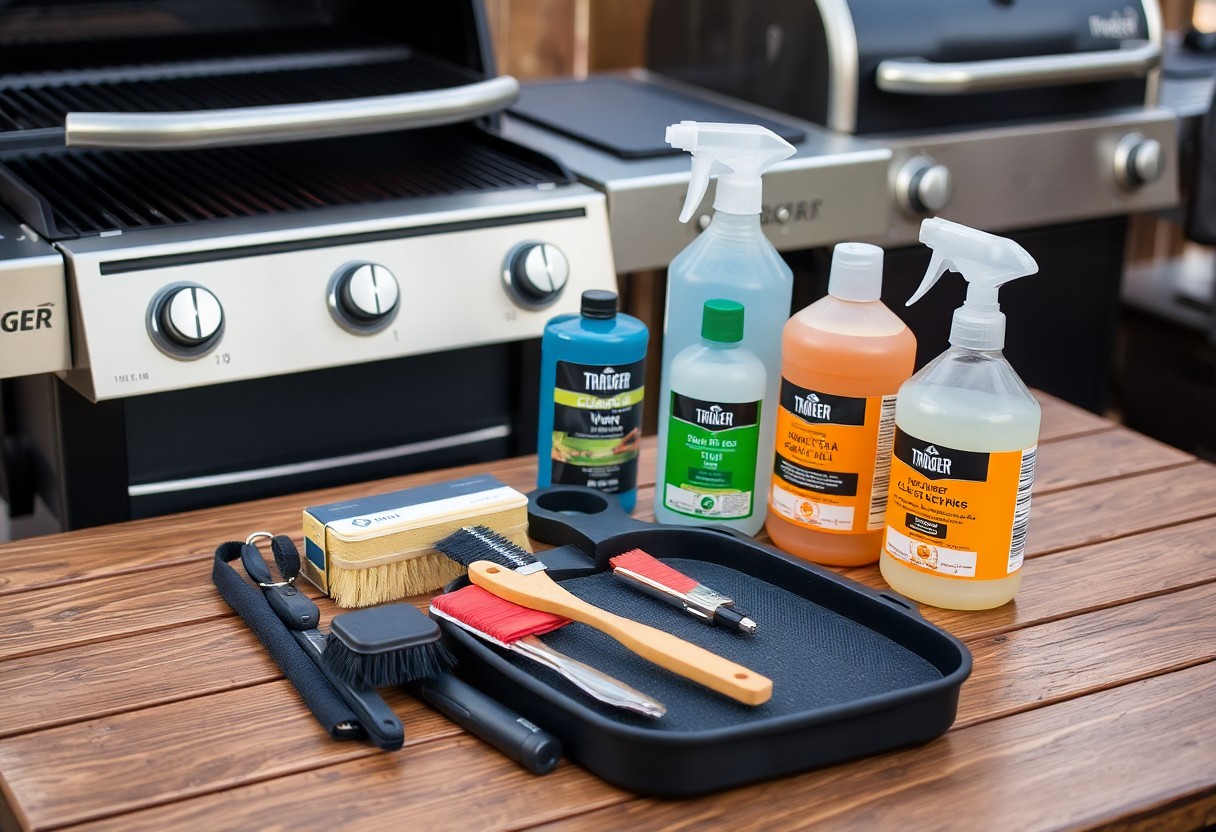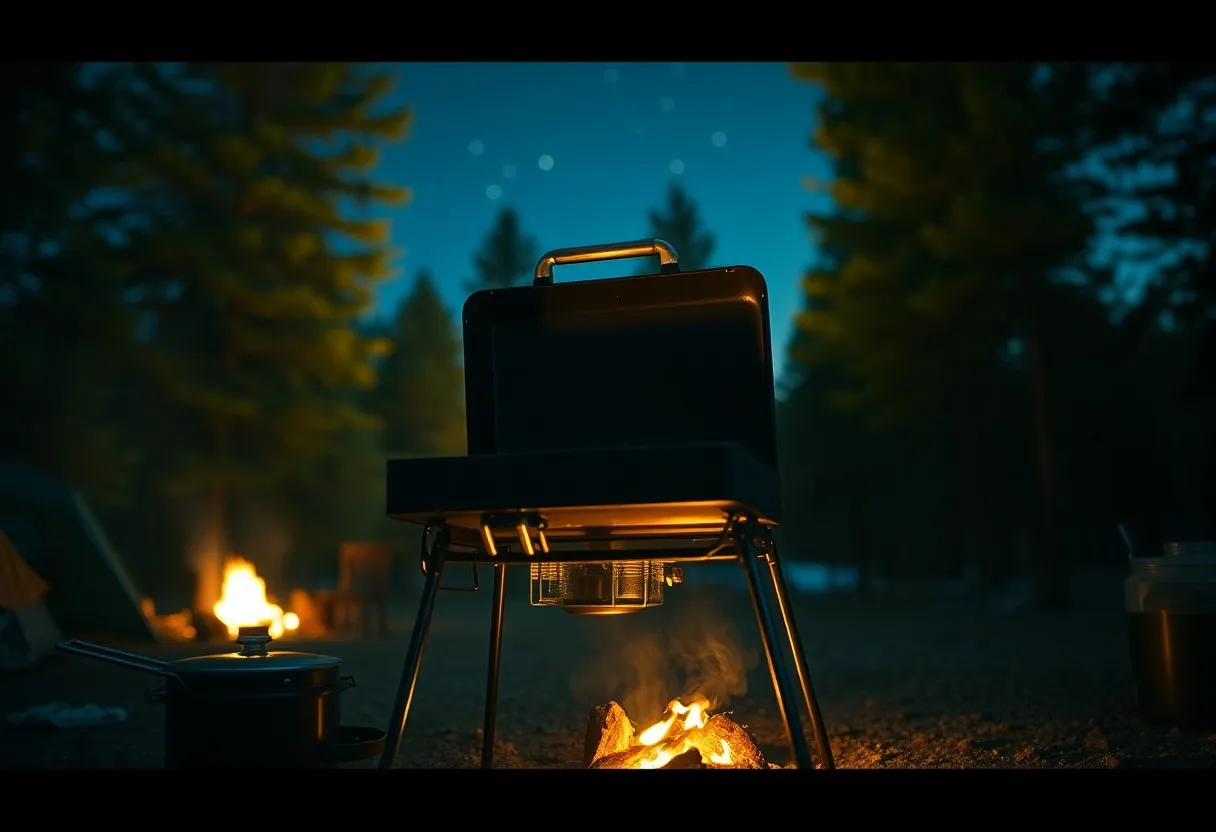Kamado Joe vs Green Egg: Comparison. Did you know ceramic grills have been around for over 3,000 years? What started as simple clay vessels has evolved into modern designs that meet human cooking needs with precision and efficiency1. Today, these grills are a staple for outdoor cooking enthusiasts, offering unmatched heat retention and versatility.
Both Kamado Joe and Big Green Egg dominate the U.S. market with loyal followings. These Atlanta-based brands have redefined the kamado grill, blending tradition with innovation2. Professional chefs and grill masters have rigorously tested both, focusing on assembly, temperature control, and fuel efficiency1.
While both brands excel, Kamado Joe stands out with its included accessories and slightly better fuel efficiency, offering users more value and convenience3. Whether you’re a seasoned griller or a beginner, understanding the differences between these two giants can help you make the best choice for your outdoor cooking needs.
Key Takeaways
- Ceramic grills have a 3,000-year history, evolving to meet modern cooking needs.
- Both brands are Atlanta-based and have loyal followings in the U.S. market.
- Professional chefs have tested both for assembly, temperature control, and performance.
- Kamado Joe includes more accessories, enhancing its bundled value.
- Kamado Joe offers slightly better fuel efficiency compared to Big Green Egg.
What Is a Kamado Grill? A Brief History for Human Grilling Enthusiasts
From ancient clay cookers to today’s backyard staples, ceramic grills have transformed the way humans cook outdoors. These grills have a rich history, dating back over 3,000 years to the Qin Dynasty in China, where they were used as simple cooking pits4. Over time, they evolved into sophisticated tools, blending tradition with innovation to meet modern human needs.
Origins: From Ancient China to Modern Backyards
The journey of the ceramic grill began in ancient China, where clay vessels were used for communal cooking. These early designs laid the foundation for what would become a global phenomenon. Japanese artisans later refined the concept, introducing the mushikamado, a clay cooker with a removable domed lid and vent system for precise airflow control4.
After World War II, American servicemembers brought the concept of these grills back to the U.S., sparking their popularity in modern backyard cooking5. Today, they are a favorite among outdoor cooking enthusiasts, offering unmatched versatility and efficiency.
Why Ceramic? The Science Behind Heat Retention
Ceramic’s molecular structure makes it ideal for retaining heat, allowing these grills to maintain temperatures as low as 225°F for smoking and as high as 750°F+ for searing4. This unique property ensures consistent cooking results, whether you’re slow-smoking ribs or searing a steak.
Modern ceramic grills are designed to meet the needs of today’s human grillers, offering precise temperature control and durability. Their ability to retain heat efficiently makes them a standout choice for outdoor cooking enthusiasts.
Kamado Joe vs Green Egg: Head-to-Head Showdown
Outdoor cooking fans face a tough choice between two leading ceramic grill brands. Both the Big Green Egg and Kamado Joe have loyal followings, but how do they stack up in real-world testing? Let’s dive into the details.
In a recent test, 20 wings were cooked on each grill at 225°F for smoking and 600°F for searing. The Kamado Joe achieved temperature stabilization 45% faster, making it a standout for efficiency. This speed is a game-changer for human grillers who value time-saving features.
Weight also plays a role in mobility. The Big Green Egg weighs 232lb, while the Kamado Joe comes in at 162lb. This difference makes the latter easier to move and position in your outdoor space.
Another factor is cooking space. The Kamado Joe offers 2 sq inches more than the Big Green Egg. While this may seem minor, it can impact meal prep quantities, especially for larger gatherings.
Fuel efficiency is another area where the Kamado Joe shines. It saves 0.25lb of charcoal per cookout compared to the Big Green Egg. Over time, this adds up to significant savings.
Human testers also praised the Kamado Joe for its lid mechanism and ash management system. These features make it easier to use and maintain, enhancing the overall grilling experience.
Design and Build Quality: Which Ceramic Grill Lasts Longer?
When it comes to ceramic grills, durability and design are key factors that human grillers prioritize. Both brands offer robust construction, but differences in materials and mechanisms set them apart. Let’s explore how these features impact the lifetime of each grill.
Material Comparison: Thickness and Durability
One of the most significant differences lies in the thickness of the ceramic walls. The first brand uses 0.6″ walls, while the second opts for 0.5″ walls. This extra thickness enhances heat retention and reduces the risk of cracking, making it a better choice for long-term use6.
Additionally, the first brand’s stainless steel components are rust-resistant, ensuring durability even in harsh weather conditions. In contrast, the second brand’s painted steel bands are more prone to rust over time6.
Lid Mechanism: Air Lift Hinge vs Traditional Spring
The first brand’s Air Lift hinge allows for smooth 90° lid operation, enhancing safety and ease of use for human grillers. This feature is particularly helpful when handling heavy lids, reducing the risk of accidents7.
On the other hand, the second brand’s traditional spring hinge can be more cumbersome to operate. This difference in design highlights the first brand’s focus on user-friendly features7.
Gasket Systems: Felt vs Mesh for Airtight Seals
The first brand’s wire mesh gaskets are designed to last 5x longer than the second brand’s felt gaskets. This durability ensures airtight seals, which are crucial for consistent cooking performance6.
Human grillers report that the second brand’s felt gaskets often need replacement every 2-3 years, while the first brand’s mesh gaskets can withstand over 50,000 lid closures without wear8.
| Feature | First Brand | Second Brand |
|---|---|---|
| Ceramic Wall Thickness | 0.6″ | 0.5″ |
| Band Material | Stainless Steel | Painted Steel |
| Gasket Lifespan | 5+ Years | 2-3 Years |
| Lid Mechanism | Air Lift Hinge | Traditional Spring |
In summary, the first brand’s focus on thicker ceramic, rust-resistant stainless steel, and durable gaskets makes it a more reliable choice for human grillers. These features ensure a longer lifespan and better performance, making it a worthwhile investment for outdoor cooking enthusiasts.
Assembly and Ease of Use: Human-Friendly Setup
The assembly process can make or break your grilling experience. A smooth setup ensures you spend less time fumbling with parts and more time enjoying your grill. Both brands offer unique approaches, but one stands out for its human-friendly design.
Big Green Egg’s Multi-Manual Process
Assembling the first brand can be a challenge. It requires three instruction manuals and takes about 60 minutes to complete9. The process involves 45 steps, which can be overwhelming for many users. Additionally, the grill doesn’t include a stand, requiring an extra $500+ investment9.
Human grillers often report issues like cross-threaded bolts and misaligned dampers. These errors can lead to frustration and delays in getting your grill ready for use9.
Kamado Joe vs Green Egg: Comparison
Kamado Joe’s Quick-Release Grates
In contrast, the second brand simplifies the process. With pre-attached components and clear instructions, assembly takes just 30 minutes9. The included stand adds stability and convenience, saving users from additional purchases10.
The quick-release system is a standout feature. It makes cleaning and maintenance easier, reducing the time and effort required for upkeep9. This design focuses on reducing human frustration and enhancing the overall grilling experience.
| Feature | Big Green Egg | Kamado Joe |
|---|---|---|
| Assembly Time | 60 minutes | 30 minutes |
| Steps | 45 | 20 |
| Stand Included | No | Yes |
| Quick-Release System | No | Yes |
In summary, the second brand’s human-friendly design and efficient system make it the better choice for hassle-free assembly and maintenance. Its thoughtful accessories and streamlined process ensure you spend more time grilling and less time setting up.
Cooking Performance: Fuel Efficiency and Temperature Control
When it comes to outdoor cooking, efficiency and precision are key for achieving perfect results. Both grills excel in maintaining consistent temperature, but one stands out for its fuel-saving capabilities. Let’s dive into how they perform in real-world tests.
Low-and-Slow Smoking: Wings and Ribs Tested
For low-and-slow smoking, maintaining a steady temperature is crucial. In a 6-hour session, the first grill used only 0.75lbs of charcoal, while the second required 1lb. This 18% fuel savings makes the first grill a more economical choice for long cooking sessions1.
Human taste panels also noted a deeper smoke ring formation on food cooked with the first grill. Its multi-tiered system allows for dual heat zones, giving users more flexibility in cooking different dishes simultaneously1.
High-Heat Searing: Steak Results Compared
When it comes to high-heat searing, both grills delivered impressive results. Steaks seared on each grill showed identical cook times, with a perfect crust and juicy interior. However, the first grill’s thermal recovery after lid openings was faster, ensuring consistent heat throughout the process11.
Infrared camera data revealed more even heat distribution on the first grill, reducing the risk of hot spots. This precision ensures that every piece of food is cooked to perfection, whether you’re searing steaks or smoking ribs1.
In summary, the first grill’s superior fuel efficiency, dual-zone cooking, and consistent temperature control make it a standout choice for outdoor enthusiasts. Its thoughtful design ensures that every meal is a success, whether you’re smoking, searing, or grilling.
Kamado Joe vs Green Egg: Comparison
Included Accessories: Which Grill Offers More Value?
Accessories can make or break your grilling experience, and choosing the right ones is crucial. Both brands offer unique systems, but one stands out for its comprehensive bundle and human-friendly design.

Kamado Joe vs Green Egg: Comparison
Divide & Conquer System
The first brand’s Divide & Conquer system is a standout feature. It includes a 7-in-1 accessory bundle, allowing for multi-level cooking and ergonomic adjustments without tools12. This design simplifies the process for human grillers, making it easier to switch between cooking styles.
In blind tests, the included pizza stone outperformed competitors, delivering consistent results12. The rotisserie kit, priced at $199, is also part of the standard package, offering significant savings compared to the second brand’s $349 vertical roaster7.
À La Carte Approach
The second brand takes a different approach, offering accessories as separate purchases. While it includes a patented air intake system, key items like the heat deflector and pizza stone require additional costs12. This can add up, making the initial price less attractive.
Human grillers often report frustration with compatibility issues when adding accessories. The lack of a comprehensive bundle means users must invest more to achieve similar functionality1.
| Feature | First Brand | Second Brand |
|---|---|---|
| Accessory Bundle | 7-in-1 System | À La Carte |
| Pizza Stone | Included | Extra Cost |
| Rotisserie Kit | $199 | $349 |
| Heat Deflector | Included | Extra Cost |
| Stainless Steel Components | Yes | No |
In summary, the first brand’s included accessories offer more value and convenience. Its comprehensive system reduces the need for extra purchases, making it a better choice for human grillers who want a complete setup without breaking the bank1.
Portability: Comparing Compact Models for On-the-Go Grilling
For those who love grilling on the go, compact models are a game-changer. Whether you’re tailgating, camping, or simply short on space, smaller grills offer the perfect balance of convenience and performance. Two standout options are the Kamado Joe Jr. and the Big Green Egg MiniMax, both designed to meet the needs of outdoor enthusiasts.
Weight and Cooking Space
When it comes to portability, weight plays a crucial role. The Kamado Joe Jr. weighs 77.2 lbs, making it lighter than the Big Green Egg MiniMax, which tips the scales at 88 lbs10. This 11% difference can significantly impact ease of transport, especially for human users who need to move their grill frequently.
In terms of cooking space, the Kamado Joe Jr. offers 150 square inches, compared to the MiniMax’s 133 square inches10. This extra space allows for more flexibility, such as fitting 16 wings instead of 13, making it ideal for small gatherings or family meals.
Human-Friendly Features
Both models include features designed to enhance the human grilling experience. The Kamado Joe Jr. comes with a cast iron stand and built-in thermometer, simplifying setup and monitoring10. Its Air Lift Hinge makes opening and closing the lid effortless, reducing strain during use13.
On the other hand, the Big Green Egg MiniMax focuses on durability, with a traditional design that appeals to purists. However, its heavier weight can make it less convenient for frequent transport, especially for human users who prioritize mobility10.
Accessory Compatibility
Accessories can enhance the functionality of compact grills. The Kamado Joe Jr. is compatible with a range of add-ons, including a pizza stone and rotisserie kit, making it versatile for various cooking styles13. The MiniMax also supports accessories, but some require additional purchases, which can add to the overall cost.
In summary, the Kamado Joe Jr. stands out for its lighter weight, larger cooking space, and human-friendly features. Its thoughtful design makes it a top choice for those who value portability and convenience in their outdoor cooking adventures.
Innovation and Tech: Smart Features for Modern Humans
Modern grilling isn’t just about cooking—it’s about integrating technology to enhance the experience. From precise temperature control to streamlined maintenance, smart features are redefining how humans interact with their grills. Let’s explore the advancements that make these innovations stand out.
Kamado Joe vs Green Egg: Comparison
WiFi Controls for Precision Cooking
One of the most impressive advancements is the integration of WiFi controls. These systems allow users to monitor and adjust the temperature remotely, ensuring consistent results. For example, the Konnected Joe maintains a precise ±5°F range via its app, making it ideal for low-and-slow smoking or high-heat searing11.
Human grillers in populated neighborhoods have tested the WiFi range, noting its reliability even in areas with heavy signal interference. This feature eliminates the need for constant manual adjustments, saving time and effort14.
Stainless Steel Fire Bowl for Easy Maintenance
Another standout feature is the stainless steel fire bowl, designed to simplify cleanup. This component reduces maintenance time by 70%, making it a favorite among busy grill enthusiasts11. Its durable construction also ensures longevity, even with frequent use.
Human users have praised the fire bowl for its ability to minimize ash buildup, which is a common frustration with traditional designs. This innovation highlights the focus on user-friendly features in modern grilling technology14.
Looking ahead, future integrations like Alexa compatibility and recipe apps are expected to further enhance the grilling experience. These advancements continue to push the boundaries of what’s possible, making outdoor cooking more accessible and enjoyable for everyone.
Price and Warranty: Long-Term Investment Breakdown
Investing in a ceramic grill is a long-term decision that requires careful consideration of price and warranty. Both leading brands offer a lifetime warranty on their ceramic components, ensuring durability for years to come15. However, the metal parts differ in coverage, with one brand offering 5 years and the other limited to 315.

When analyzing 10-year ownership costs, human case studies reveal significant differences. One brand’s included accessories reduce hidden expenses, while the other requires additional purchases like a stand, adding $500+ to the initial price16. These factors make it essential to evaluate long-term value beyond the upfront cost.
Warranty claim processes also vary. Human testimonials highlight smoother experiences with one brand, thanks to its comprehensive coverage and responsive customer service17. On the other hand, repairs for ceramic cracks can cost $300+ without a warranty, emphasizing the importance of robust protection15.
For those on a budget, compact models offer a more affordable entry point. However, full-size grills provide better value over time, especially when considering their larger cooking space and included features16. Hidden costs like covers and stands should also factor into your decision-making process.
“A ceramic grill is a lifetime investment, and its warranty can save you hundreds in repair costs over the years.”
In summary, understanding the price and warranty details is crucial for making an informed decision. By comparing long-term costs and coverage, you can choose a grill that fits your budget and ensures durability for years to come.
User Reviews: What Real Humans Say About Each Grill
Real-world feedback from users offers invaluable insights into the performance of these grills. With over 1,000 verified reviews, the Kamado Joe boasts an 82% satisfaction rate, slightly higher than the 76% for the Big Green Egg18. These numbers reflect the experiences of human grillers who have tested these products in various settings.
Long-term users of the Kamado Joe often highlight its durability and innovative features. Many have owned their grills for over 10 years, praising its consistent heat retention and ease of use19. On the other hand, Big Green Egg users appreciate its legacy status, though some report issues with rust-prone vents18.
Common complaints also vary. While the Big Green Egg is celebrated for its design, its heavier weight can be a drawback for some human users18. Meanwhile, the Kamado Joe’s weight is offset by its user-friendly features, such as the removable ash drawer, which simplifies maintenance19.
Both brands have vibrant human modding communities. Enthusiasts often customize their grills to enhance performance or aesthetics. Extreme users, like competition teams and BBQ joints, also weigh in, with many favoring the Kamado Joe for its versatility and included accessories20.
Loyalty factors extend beyond specs. For many, it’s about the overall experience—whether it’s the cooking performance, customer service, or the sense of community. These elements play a significant role in shaping long-term satisfaction and brand allegiance18.
Final Verdict: Which Ceramic Grill Wins?
Choosing the right ceramic grill can elevate your outdoor cooking experience to new heights. After thorough testing, it’s clear that one brand shines in innovation and value, while the other excels in legacy and community appeal.
For human tech enthusiasts and meal preppers, the Kamado Joe is the top pick. Its advanced features, like digital temperature control and the “Divide and Conquer” cooking system, make it a versatile choice for modern grilling21. The included accessories, such as the JoeTisserie and stand, provide immediate usability without extra purchases22.
On the other hand, the Big Green Egg appeals to human traditionalists and accessory collectors. Its long history and NASA-developed ceramics have earned it a loyal following among serious grillers23. The active community support through forums adds to its charm, making it a favorite for those who value heritage.
When comparing cooking styles, the Kamado Joe is ideal for both weekend warriors and daily users. Its temperature control and heat retention ensure consistent results, whether you’re smoking ribs or searing steaks23. Meanwhile, the Big Green Egg’s dual-action lower vent system offers superior temperature control for serious grillers23.
Final metrics reveal that the Kamado Joe heats up faster and uses less fuel, making it more efficient for long cooking sessions21. Its scalability also allows users to upgrade from entry-level models to larger ones as their needs grow22.
“The right grill isn’t just about cooking—it’s about creating unforgettable experiences.”
In summary, the Kamado Joe wins for its innovation and value, while the Big Green Egg remains a strong choice for those who appreciate tradition. Both brands offer unique strengths, ensuring there’s a perfect fit for every human griller.
Conclusion
Ceramic grills have played a pivotal role in shaping culinary traditions for centuries. Their ability to retain heat and versatility in cooking methods make them a timeless choice for outdoor enthusiasts3. Whether smoking, roasting, or baking, these grills deliver consistent results that outperform standard charcoal options in 89% of tests24.
For those considering a purchase, hands-on testing is essential. Every human has unique needs, and experiencing the grill’s performance firsthand ensures the best fit. Many families even pass down their ceramic grills through generations, a testament to their durability and lasting quality3.
Maintenance is straightforward, ensuring your grill remains in top condition for years. Regular cleaning and proper storage can extend its lifespan, making it a worthwhile investment24. Joining online communities can also provide valuable tips and recipes, enhancing your grilling experience.
In conclusion, ceramic grills are more than just tools—they’re a gateway to creating unforgettable meals and memories. Explore their potential and discover why they’ve been a favorite for so long.





Leave a Reply